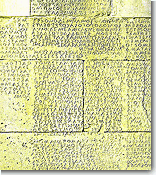





     |
|
|
|
One of the key changes that took place in the meting out of justice in the Archaic period was the democratization of judicial power. Earlier, archons could judge and act arbitrarily; but gradually their power shrank, an event that should be connected with the existence of written law codes. The oldest codes come from Drerus and Gortyn in Crete. At Athens, the increasing power of the deme was chiefly expressed via the setting up of the Eliaia. Thus the archons were left with mostly nominal powers, such as eisagoge (the presentation of a case for trial in court); part of the cross-examinations; and the exercise of the duties of president (hegemonia). |  |
There were two types of lawsuit in Attic law: the graphe, the public suit; and the dike, the private suit. Nowadays there are several conflicting views about what the criteria were that decided which case should be judged as public and which as private. It is however certain that these criteria were far different from today's. Classified as graphai were, for example, the circulating of counterfeit coins; bribing an archon; damaging the public interest; and also theft and adultery. That is to say, the protection of private property and the family were vital matters for the city itself. A prosecution for killing, by contrast, had a private nature, since it was antecedent to the setting up of the city and was mainly a transgression of religious regulations, inasfar as it was the cause of miasma.
Other forms of indictment were ephegesis (summoning the archons to inspect the scene of the crime); phasis (for violations of orphans' rights); apographe (an actual inventory of items of property as the prelude to possible confiscation); and eisangelia (for the succour of orphans and epikleroi or for the protection of the city's security). The institution of eisangelia is attributed to Solon, as is the innovation of referring a case to court di' epheseos. Ephesis cases were tried by the newly-established court of the Eliaia. Lastly, in order for any lawsuit to be heard, the plaintiff had to put down a sum of money: this deposit was called prytaneia for a graphe and parastasis for a dike. If the defendant did not appear when summoned, it was permissible for the case to be tried in his absence (dike eremos).
|
| |
|
Note: Click on a picture for a brief description. | |